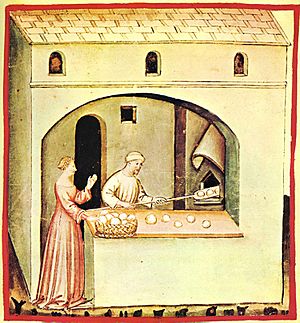Vantage loaf facts for kids
A vantage loaf is an extra loaf of bread. It's the 13th loaf you get when you buy a baker's dozen. This means you get one more loaf than you paid for! The idea of a vantage loaf was first written down in 1612. It was a way for buyers to get a little something extra.
Why Bakers Gave Extra Bread
In the 1200s, England had a law about selling bread and ale. It was called the Assize of Bread and Ale. This law made sure bakers sold the right amount. If a baker sold too little, they could get into big trouble. They might have to pay a fine. Their oven could even be broken! Sometimes, they might even be put in a pillory. A pillory was a wooden frame where people were locked up in public. It was a way to shame them.
To avoid trouble, bakers started adding a little extra bread. For small orders, they would add a small piece. This was called an "in-bread." It made sure they were not accused of cheating. If someone ordered 12 loaves, bakers would give a whole extra loaf. This extra loaf was the vantage loaf. It was a smart way to protect themselves and keep customers happy.
How Hucksters Used the Vantage Loaf
Sometimes, bakers made more bread than they could sell. This often happened after a good harvest. They would sell this extra bread to people called "hucksters." Hucksters were like street sellers. They would buy bread from bakers and then sell it in the streets.
The price of bread was set by law. So, hucksters couldn't just charge more. Instead, they made their money from the extra 13th loaf. This extra loaf was the vantage loaf. They got it for free from the baker. Then, they could sell it and make a profit. It was a clever way for hucksters to earn money.


